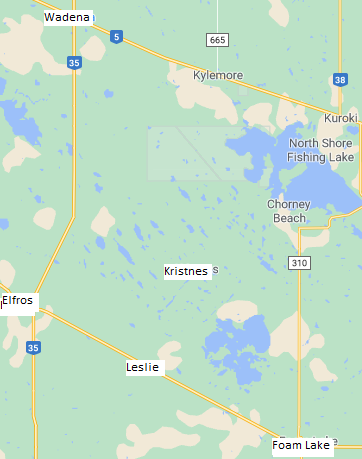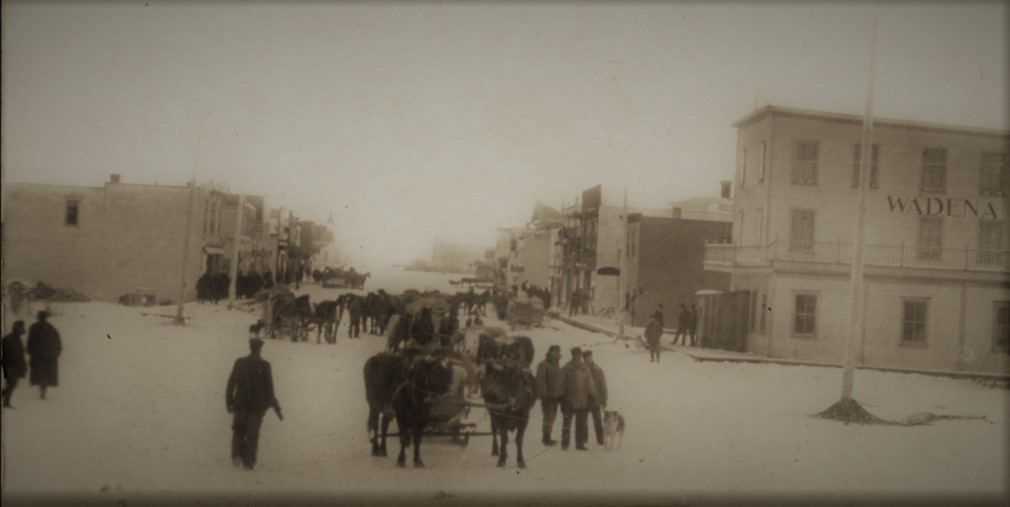
Icelandic settlement in the Northwest Territories, which became Saskatchewan in 1905, is often divided in two periods. The first started in 1887 and ended around the turn of the century, centered near Foam Lake. The majority of settlers, in this period, came directly from Iceland, sometimes after a stay in Winnipeg. The second period began in the year 1900 as increasing numbers of settlers arrived from other Icelandic settlements in Manitoba, Minnesota, and N. Dakota. These settlers had either been born in Iceland and grown up in such communities or had been born in the community. Now they had started their own families but were unable to find available land and were forced to search elsewhere and headed west. The railway companies, Canadian Pacific Railroad and Canadian National Railroad had reached the Territories with their tracks, C.N.R reached Wadena in 1905 while C.P.R. was in Foam Lake in 1907. Icelandic settlers, now accustomed to farming in America, preferred mixed farming, i.e., growing grain as well as raising livestock. Thus they tended to look for farmland well suited for both; such was the case in N. Dakota around 1880, in the Argyle Settlement in Manitoba about the same time, and in the Thingvalla Settlement in Northwest Territories towards the end of that decade. Tómas Þórðarson (Thomas Thordarson,) son of Þórður Pálsson, who farmed at Hólar in Öxnadalur in Eyjafjarðarsýsla. Tómas homesteaded in the Thingvalla Settlement in 1889 and west of Foam Lake in 1898, and was hired as an agent by Canadian Authorities to assist Icelandic settlers in settling in the new area north and west of Foam Lake. He was equal to the task, first and foremost for his experience after two settlements in the Territories. His priorities were twofold; first he encouraged Icelanders to establish small colonies together where they could preserve Icelandic heritage and language. There were some Icelandic leaders who opposed such attempts, they encouraged Icelanders to settle and live among settlers of different nationalities thus integrating quickly and becoming good Canadians sooner. Secondly, he urged his countrymen to search for land suitable for mixed farming. He was well aware of the huge flat prairie land west of Kandahar now open to new settlers, yet he guided his countrymen to a region of sloughs, poplar bluffs and willow bushes. Plenty of hay could be made, flatland broken, and plenty of building material as well as firewood available. Most followed Tómas´ advice, but some from the Argyle settlement ignored his suggestion and continued west. He knew what he was saying, many farmers in the Kristnes Settlement managed to keep their animals alive during the dry cycle in the 1930s while the grain growers further west lost all crops year after year.
Icelandic Settlement: Jón Sigfússon Thorlacius, (Jon Thorlacius), son of Rev. Sigfús Einarsson Thorlacius at Núpufell in Eyjafjarðarsýsla, was the first to homestead in the new area in 1903. He selected land, built his house, and settled into life there. A year later he opened a post office in his home called the Kristnes Post Office, which he managed for a few years. Jónas Samsonarson (Jonas Samson) arrived the same year as Jón and homesteaded near Kristnes. There he opened a small store in his home and a few years later he took over the Kristnes P.O. Tómas Hördal (Hordal) from Ketilsstaðir in Dalasýsla, emigrated from Iceland in 1887, along with his wife, Margrét Benediktsdóttir and daughters. He lived in N. Dakota until 1903, moved that year to Kristnes and homesteaded. He was a blacksmith and soon opened a shop on his farm which he managed for some time. Two brothers, Friðrik (Fred E. Vatnsdal) and Þórður (Thomas Vatnsdal), sons of Eggert Magnússon from Barðastrandarsýsla, opened a general store in Wadena and added a lumber yard a little later. Ingvar Ólafsson from Árnessýsla joined the business a little later but after a few years, moved to Foam Lake. Pétur Nikulásson (Peter N. Johnson) from N. Múlasýsla started a livestock business and was quite successful. He bought his animals in Manitoba and transported them on the C.N.R railway to Wadena. One occasion in 1908 was quite memorable to him, he brought animals on the train to Wadena as usual and sold just about every animal before even one was removed from the train, such was the demand. Settlers would arrive in Wadena, and purchase supplies before heading out to their settlement. In 1905 a new school district was established called Akra School District No. 1267 and in 1908 it needed to be expanded as the community had grown and was hence called Kristnes School District No. 1267. Þorvaldur Þorvaldsson (Th. Thorvaldson) from Kelduskógar on Berufjarðarströnd was a trustee for number of years, he and his wife, Gróa Jónsdóttir also settled in 1903.

The village of Wadena was given that name by Scandinavian settlers arriving from Wadena, Minnesota. The Wadena in Minnesota got its name from a Chippewa/ Saulteaux Chief. The photo shows the village in winter in the first decade of the 20th century. Sleighs loaded with supplies are pulled by oxen and horses.
English version by Thor group.
